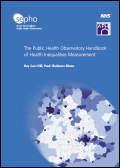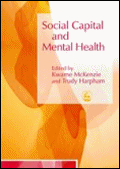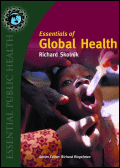SELECTED FOR YOU... JUNE 2008: books of the month - working papers
All the Selected for you
BOOKS
The Public Health Observatory Handbook of Health Inequalities Measurement.
Car-Hill R., Chalmers-Dixon P.
Oxford ; Sepho : 2005 : 216 p.
This new SEPHO handbook primarily focuses on the measurement and interpretation of health inequalities. Written by Roy Carr-Hill and Paul Chalmers-Dixon of York University, it provides a comprehensive collection of material for those concerned to document and understand health inequalities.
Social capital and mental health.
Wilkinson R., Mckenzie K., Harpham R.
Londres : Jessica Kingsley Publishers : 2006 : 160 p.
Why do some areas have a higher prevalence of mental illness than others? How does the structure of a society affect its inhabitants' mental health? This remarkable book is the first to explore in detail the concept of social capital and its implications for mental health policy. Drawing on evidence from international research and fieldwork, the contributors examine the risk factors for mental health associated with both low and high social capital communities. They discuss the importance of relationships between individuals, groups and abstract bodies such as the state and outline different systems of social capital, for example intra-group 'bonding' and inter-group 'bridging'. The authors challenge the notion of community as a strictly area-based concept and call for broader-based studies of communities built around race, faith or even around a common social exclusion. Social Capital and Mental Health also reviews methods of measuring social capital, analyses the implications of research findings for future policy developments and makes clear recommendations for future practice and research.
Essentials of global health.
Skolnik R.
Sudbury : Jones and Bartlett Publishers : 2008 : 322 p.
This book is an introduction to the most critical issues in global health. While the book offers a global perspective, particular attention is given to the health-development link, to developing countries, and to the health needs of poor and disadvantaged people. Organized in four parts the book explores the principles, measurements, and the Health-Development Link (principles of Global Health; Health Determinants, Measurements, and Trends; and Health, Education, Poverty, and the Economy) ; cross-cutting global health themes (human rights, ethics, and global health; An Introduction to health systems; and culture and Health.) ; the burden of disease (environment and health; nutrition and health; women's health; child Health; infectious diseases; non-communicable diseases; and unintentional injuries); working together to Improve global health (conflicts, natural disasters, and other Emergencies; cooperating to improve global health; and, science technology, and the public's health).
WORKING PAPERS
Health Insurance
Adverse selection in the U.S. health insurance markets: Evidence from the MEPS (Medical Expenditure Panel Survey). 

Di Novi C.
Alessandria : Universita' del Piemonte Orientale : 2008/04 : 38 p.
We use the 2003/2004 Medical Expenditure Panel Survey in conjunctions with the 2002 National Health Interview Survey to test for adverse selection in the U.S. private health insurance market. The key idea is to test whether the individuals who are more exposed to health risks also buy insurance contracts with more coverage or higher expected payments. The critical statistical problem is that the extension of insurance is only measured for those who are insured and face positive health care expenditure. So there is a possible sample selection bias effect. The procedure used is based on a method suggested by Wooldridge (1995). The method also accounts for heterogeneity across individuals. The simultaneous account taken of both possible sources of bias is new for this kind of application.
Less Social Health Insurance – More Private Supplementary Insurance? – Empirical Evidence from Germany. 

Augurzky B., Tauchmann H.
Essen : RWI : 2008/05 : 19 p.
This paper uses individual level data to analyze the effect of changes in the compulsory benefit package of the German statutory health insurance scheme on the demand for private supplementary insurance. In particular, we aim at measuring the effect of excluding dentures from the benefit package in 1997 as well as the effect of re-including them in 1999. A difference-in-differences estimator is used. Individuals born prior to 1979 serve as control group because only the young were affected by the reform.Our results do not exhibit any significant effects on the demand for supplementary health insurance. Thus, the hypothesis that clients do make informed choices about their health insurances' coverage is not supported.
Healthy, wealthy and insured? The role of self-assessed health in the demand for private health insurance. 
 .
.
Doiron D., Jones G, Savage E.
Sydney : Centre for Health Economics Research and Evaluation : 2006/05 : 30 p.
Both adverse selection and moral hazard models predict a positive relationship between risk and insurance; yet the most common finding in empirical studies of insurance is that of a negative correlation. In this paper we investigate the relationship between ex ante risk and private health insurance using data from the 2001 Australian National Health Survey (NHS). The Australian health system provides a setting where the relationship between risk and insurance is more transparent than many other institutional frameworks; private health insurance is not tied to employment; community rating limits the actions of insurers; and private coverage is high for a country providing free public hospital treatment. We find a strong positive association between self-assessed health and private health cover. We use the detailed information available in the NHS to investigate whether we can identify factors responsible for the negative correlation between risk (lower SAHS) and insurance cover. However this relationship persists despite the inclusion of a large set of controls for personal and socio-economic characteristics, risk-related behaviours, objective health measures and an index of mental health. The opposite effect of self-assessed health and long-term conditions on coverage suggests that SAHS is capturing factors such as personality or risk preferences.
Health expenditure
Out-of-pocket health expenditures in Australia: a semi-parametric analysis. 

Savage E., Jones G., Von Gool K.
Sydney : Centre for Health Economics Research and Evaluation : 2007/05 : 27 p.
Out-of-pocket health expenditures in Australia are high in international comparisons and have been growing at a faster rate than most other health costs in recent years. This raises concerns about the extent to which out-of-pocket costs have constrained access to health services for low income households. Using data from the ABS Household Expenditure Survey 2003-04, we model the relationships between health expenditure shares and equivalised total expenditure for categories of out-of-pocket health expenditures and analyse the extent of protection given by concession cards. To allow for flexibility in the relationship we adopt a semi-parametric estimation technique following Yatchew (1997). We find mixed evidence for the protection health concession cards give against high out-of-pocket health expenditures. Despite higher levels of subsidy, households with concession cards have higher total health expenditure shares than other households. Surprisingly, the major drivers of the difference are not categories of expenditure where cards offer little or no protection, such as dental services and non-prescription medicines, but prescriptions costs, where concession cards guarantee a subsidy, and specialist consultations, where bulk billing rates would be expected to be higher for cardholders. This is the first detailed distributional analysis of household health expenditures in Australia.
Moving towards more sustainable healthcare in financing in Germany. 

Brandt N.
Paris : OCDE : 2008/05 : 28 p.
La réforme récente du secteur de la santé vise à assurer un financement plus viable des dépenses de santé en réduisant leurs effets négatifs sur l'emploi et en améliorant leur efficacité économique grâce à une concurrence accrue. Si l'augmentation prévue des contributions budgétaires se matérialise, elle permettra un certain découplage entre le financement du secteur de la santé et les revenus du travail. Une meilleure répartition des risques entre les assureurs pourrait réduire la tendance à une sélection des risques, si bien que la concurrence pourrait en fait conduire à une plus grande efficacité économique. Cela étant, la segmentation du système de santé dans un marché où cohabitent assurance privée et assurance publique continuera de poser des problèmes d'équité et d'efficacité. Par sa conception même, le nouveau système de financement de l'assurance maladie publique limite et fausse les signaux transmis par les prix ; il faudra donc remédier à ce problème pour permettre à la concurrence de produire les résultats souhaités. Une plus grande liberté des relations contractuelles entre assureurs, prestataires de soins et laboratoires pharmaceutiques permettrait sans doute de tirer un meilleur parti de la concurrence, mais les autorités devront faire preuve de vigilance et adapter les conditions cadres le cas échéant.
Health inequalities
Healthy, wealthy, and wise : socioeconomic status, poor health in childhood, and human capital development. 

Currie J.
Cambridge : NBER : 2008/05 : 53 p.
There are many possible pathways between parental education, income, and health, and between child health and education, but only some of them have been explored in the literature. This essay focuses on links between parental socioeconomic status (as measured by education, income, occupation, or in some cases area of residence) and child health, and between child health and adult education or income. Specifically, I ask two questions: What is the evidence regarding whether parental socioeconomic status affects child health ? And, what is the evidence relating child health to future educational and labor market outcomes? I show that there is now strong evidence of both links, suggesting that health could play a role in the intergenerational transmission of economic status.
Medicines
Pharmacy in England : White paper. 

Galbraith A.
Londres : Her Majesty's Stationary Office : 2008 : 139 p.
This White Paper sets out a vision for building on the strengths of pharmacy, using the sector's capacity and capability to deliver further improvements in pharmaceutical services over the coming years as part of an overall strategy to ensure safe, effective, fairer and more personalised patient care. It includes the Government's response to the review of NHS pharmaceutical contractual arrangements conducted by Anne Galbraith, former chair of the Prescription Pricing Authority, which the Government commissioned in 2007. It also considers, where appropriate, views put forward by the All-Party Pharmacy Group's report The Future of Pharmacy (published in 2007), and considers the complementary but important work of dispensing doctors and appliance contractors.
Pharmaceutical innovation and the longevity of Australians: a first look. 

Lichtenberg F.R., Duflos G.
Cambridge : NBER : 2008/05 : 23 p.
We examine the impact of pharmaceutical innovation on the longevity of Australians during the period 1995-2003. Due to the government's Pharmaceutical Benefits Scheme, Australia has much better data on drug utilization than most other countries. We find that mean age at death increased more for diseases with larger increases in mean drug vintage. The estimates indicate that increasing the mean vintage of drugs by 5 years would increase mean age at death by almost 11 months. The estimates also indicate that using newer drugs reduced the number of years of potential life lost before the ages of 65 and 70 (but not before age 75). During the period 1995-2003, mean age at death increased by about 2.0 years, from 74.4 to 76.4. The estimates imply that, in the absence of any increase in drug vintage, mean age at death would have increased by only 0.7 years. The increase in drug vintage accounts for about 65% of the total increase in mean age at death. We obtain a rough estimate of the cost per life-year gained from using newer drugs. Under our assumptions, using newer drugs (increasing drug vintage) increased life expectancy by 1.23 years and increased lifetime drug expenditure by $12,976; the cost per life-year gained from using newer drugs is $10,585. An estimate made by other investigators of the value of a statistical Australian life-year ($70,618) is 6.7 times as large as our estimate of the cost per life-year gained from using newer drugs. We discuss several reasons why our estimate of the cost per life-year gained from using newer drugs could be too high or too low.
Primary health care
Health workforce and international migration : can New Zeland compete? 

Zurn P., Dumont J.C.
Paris : OCDE : 2008 : 74 p.
Ce document examine les effectifs de professionnels de la santé et les politiques migratoires de la Nouvelle-Zélande, en se concentrant plus particulièrement sur le recrutement international de médecins et d'infirmières. En Nouvelle-Zélande comme dans tous les pays de l'OCDE, ces professionnels jouent un rôle crucial dans le système de santé. Dans ce pays, pourtant, peut-être plus que dans tout autre pays de l'OCDE, on ne saurait étudier les travailleurs de la santé sans prendre en compte la dimension internationale de cette population. La Nouvelle-Zélande compte la proportion de médecins immigrés la plus élevée de tous les pays de l'OCDE, celle des infirmières immigrées comptant aussi parmi les plus fortes. Le pays ne s'est pas doté d'une politique d'immigration particulière concernant ces professions même si les filières d'immigration permanente ou temporaire font qu'il est relativement facile pour les médecins et les infirmières qui parviennent à faire reconnaître leurs diplômes d'aller s'installer en Nouvelle-Zélande. En parallèle, le pays présente également des taux élevés d'émigration de travailleurs de la santé (principalement vers les autres pays de l'OCDE). En matière de gestion des ressources humaines de la santé, les migrations internationales représentent donc à la fois une chance et une difficulté pour la Nouvelle-Zélande. La concurrence internationale croissante pour attirer des travailleurs hautement qualifiés soulève des problèmes importants comme la soutenabilité et la capacité à affronter cette concurrence sur un marché mondialisé. Dans ce contexte, il faudrait peut-être réfléchir à de nouvelles stratégies pour améliorer le recrutement international de travailleurs de la santé et élaborer d'autres mesures possibles. Quant à ce recrutement, l'amélioration de la coordination et le renforcement de la collaboration entre les principales parties prenantes pourraient contribuer à le rendre plus effectif et plus approprié.
Agent model with a monopoly power: physicians. 

Desquin B., Holly A., Rochaix L.
Lausanne : IHEM : 2007/05 : 28 p.
The aim of this paper is to model a liberal profession, in this case physicians. We propose a model in which the physician acts in the same way as an agent who maximises his utility function subject to his budget constraint, while at the same time being able to affect his rate of remuneration. This model presupposes that physicians attempt to reach two targets, namely income and leisure, and that the trade-off between these two targets depends on their monopolistic power. Unlike existing models, our proposed model advances that some physicians may have a disutility for leisure and may adopt altruistic or strategic behaviours. To determine the relevance of our model, we estimate salaried, firm and agent versions of the model based on a sample of 317 physicians practicing in the Provence-Alpes-Côte d'Azur region (PACA). We observe that physicians do not act like a purely profit-maximising firm. Furthermore, they are able to affect their net remuneration rate through their labour supply. The model that we propose therefore is of particular importance. We estimate that around 20% of physicians experience disutility from leisure, which can be explained by their adoption of altruistic and strategic behaviours.
Health systems, Health policies
Payment for Performance (P4P): International experience and a cautionary proposal for Estonia. 

Maynard A.
Danemark : OMS, Bureau régional de l'Europe : 2008 : 36 p.
Some health systems in Europe use financial incentives for hospitals and specialist physicians linked to process and outcome indicators of performance in an attempt to improve health gain. This is called paying for performance (P4P). Can Estonia's health system reward value for money and improved quality in hospital and other specialized care and, if so, how? These questions are discussed in this WHO report.
Health care policy evaluation: empirical analysis of the restrictions implied by Quality Adjusted Life Years. 

Viney R., Savage E.
Sydney : Centre for Health Economics Research and Evaluation : 2006 : 23p.
This paper investigates the nature of the utility function for health care, defined over the probability of survival, survival duration, health state and cost of treatment. A discrete choice experiment, involving treatment choice for a hypothetical health condition is used to test restrictions on preferences in the QALY model. We find that preferences do not conform to expected utility, and there are significant interactions between health state and survival duration. Individual characteristics are significant, implying substantial differences in valuations of health states across the population. The results suggest the QALY approach distorts valuations of health outcomes.


